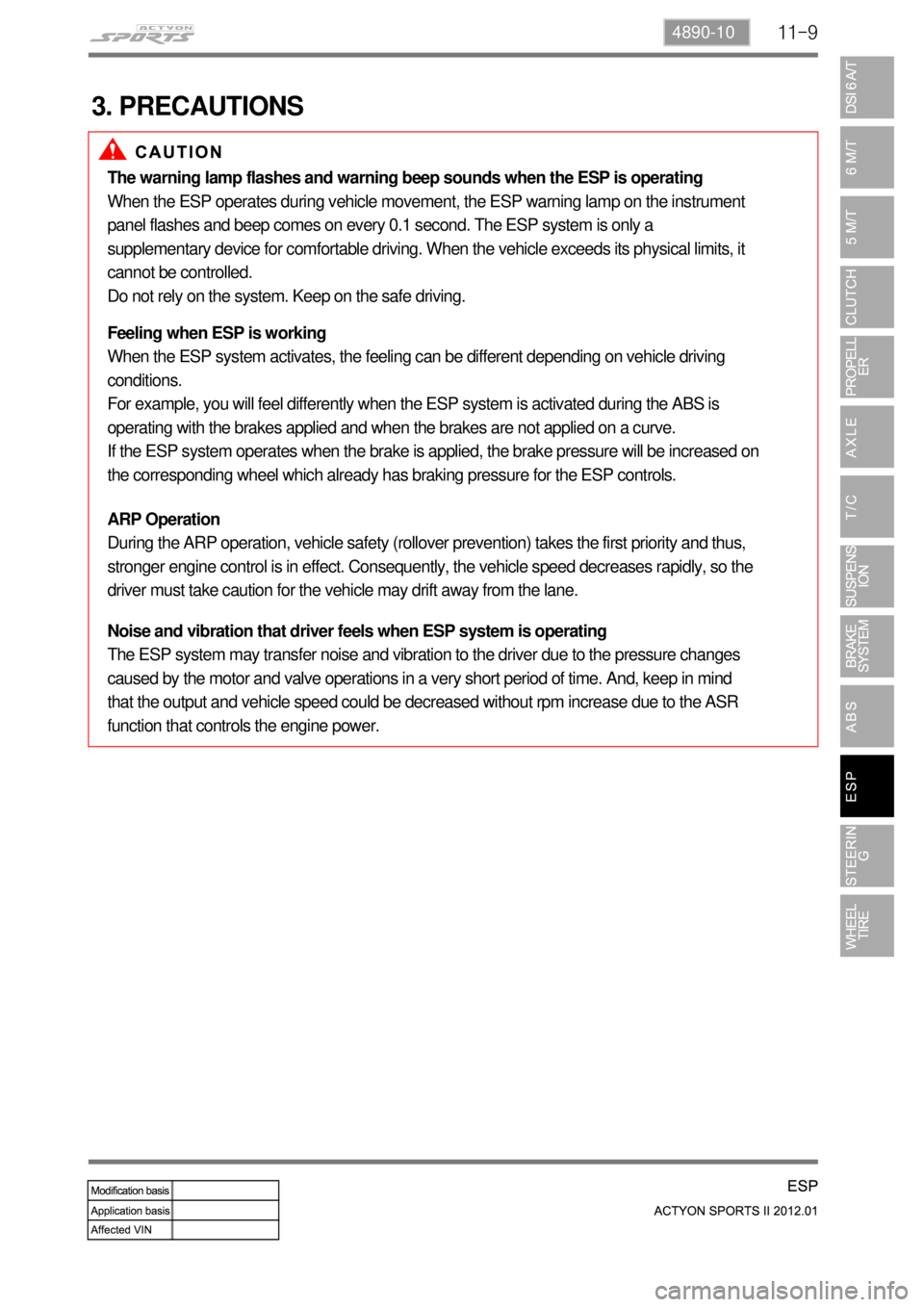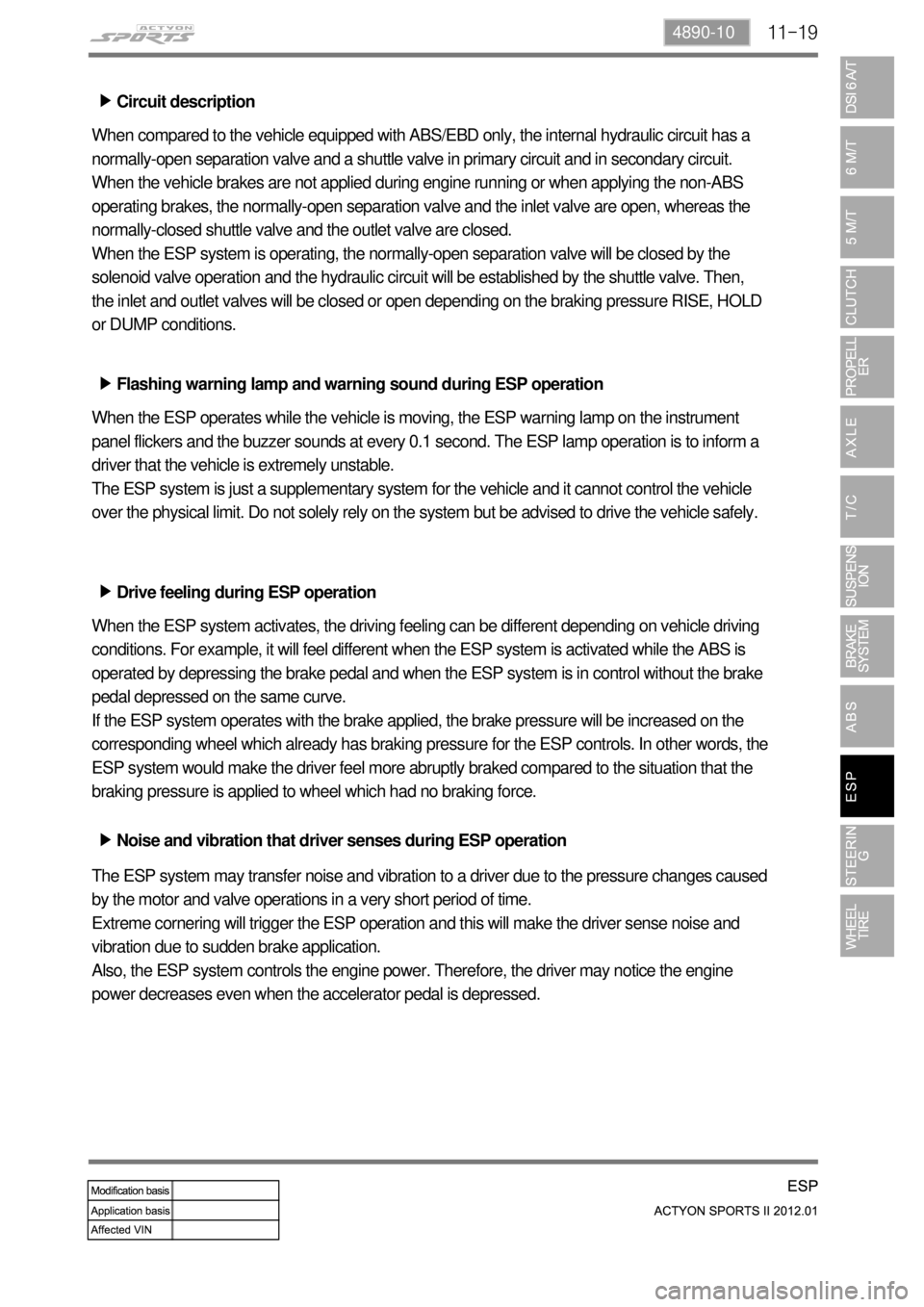Page 697 of 828
10-18
4) ABS Control Pattern
The ABS control is performed by comparing the reference speed with each wheel speed. Firstly,
it is determined whether the vehicle is in the deceleration or acceleration state using the wheel
speed change ratio. Then, a signal is transmitted to the valve.
Finally, the brake pressure is adjusted via the signal.
△V: Vehicle speed
Vref: Vehicle speed reference
Vw: Wheel speed
Page 710 of 828

11-94890-10
3. PRECAUTIONS
The warning lamp flashes and warning beep sounds when the ESP is operating
When the ESP operates during vehicle movement, the ESP warning lamp on the instrument
panel flashes and beep comes on every 0.1 second. The ESP system is only a
supplementary device for comfortable driving. When the vehicle exceeds its physical limits, it
cannot be controlled.
Do not rely on the system. Keep on the safe driving.
Feeling when ESP is working
When the ESP system activates, the feeling can be different depending on vehicle driving
conditions.
For example, you will feel differently when the ESP system is activated during the ABS is
operating with the brakes applied and when the brakes are not applied on a curve.
If the ESP system operates when the brake is applied, the brake pressure will be increased on
the corresponding wheel which already has braking pressure for the ESP controls.
ARP Operation
During the ARP operation, vehicle safety (rollover prevention) takes the first priority and thus,
stronger engine control is in effect. Consequently, the vehicle speed decreases rapidly, so the
driver must take caution for the vehicle may drift away from the lane.
Noise and vibration that driver feels when ESP system is operating
The ESP system may transfer noise and vibration to the driver due to the pressure changes
caused by the motor and valve operations in a very short period of time. And, keep in mind
that the output and vehicle speed could be decreased without rpm increase due to the ASR
function that controls the engine power.
Page 717 of 828

11-16
4) HBA (Hydraulic Brake Assist System)
(1) Purpose
HBA (Hydraulic Brake Assist) system helps in an emergency braking situation when the driver
applies the brake fast, but not with sufficient pressure, which leads to dangerously long braking
distance. ECU recognizes the attempt at full braking and transmits the signal calling for full brake
pressure from the hydraulic booster. An inexperienced, elderly or physically weak driver may suffer
from the accident by not fully pressing the brake pedal when hard braking is required under
emergency. The HBA System increases the braking force under urgent situations to enhance the
inputted braking force from the driver. Based on the fact that some drivers depress the brake
pedal too soft even under when hard braking is necessary, the HECU system is a safety
supplementary system that builds high braking force during initial braking according to pressure
value of the brake pressure sensor and the pressure changes of the pressure sensor intervals.
When the system is designed to apply high braking force when brake pedal is depressed softly by
an elderly or physically weak driver, the vehicle will make abrupt stopping under normal braking
situation due to high braking pressure at each wheels.
(2) Operation
The brake pressure value and the changed value of the pressure sensor are the conditions in
which the HBA System operates. There are 2 pressure sensors under the master cylinder. When
the ESP ECU system determines that emergency braking is present, the pump operates, the
brake fluid in the master cylinder is sent to the pump and the braking pressure is delivered to the
wheels via the inlet valves . If the drive depress the brake pedal slowly, the pressure change is not
high. In this case, only the conventional brake system with booster is activated.
(3) Operating conditions
Sensor pressure: over 40 bar
Pressure changes: over 850 bar/sec
Vehicle speed: over 30 km/h -
-
-
Page 718 of 828

11-174890-10
5) ARP (Active Roll-Over Protection
The ARP (Active Roll-over Protection) system is a safety assistant device that minimizes, by
controlling brakes and the engine, the physical tendency of the vehicle rollover during sharp lane
changes or U-turns. For the system, software is added to the existing ESP system and no
additional device or switch is needed. One must note that the ARP system, just as general
assistant devices including the ABS, is only a safety assistant device using the ESP system and its
function is useless when the situation overcomes the physical power. Following picture shows
how the ARP compensates the vehicle position by varying each wheel's braking power to
overcome the physical tendency of the vehicle rollover during sharp turns.
Lateral sensor
(In sensor cluster)
Vehicle speedBrake force
Radius
The vehicle driving condition is controlled by the internally programmed logic according to the
input signals from wheel speed sensor, steering angle sensor and lateral sensor.
During the ARP operation, vehicle safety (rollover prevention) takes the first priority and thus,
stronger engine control is in effect. Consequently, the vehicle speed decreases rapidly, so the
driver must take caution for the vehicle may drift away from the lane.
Page 720 of 828

11-194890-10
Circuit description ▶
When compared to the vehicle equipped with ABS/EBD only, the internal hydraulic circuit has a
normally-open separation valve and a shuttle valve in primary circuit and in secondary circuit.
When the vehicle brakes are not applied during engine running or when applying the non-ABS
operating brakes, the normally-open separation valve and the inlet valve are open, whereas the
normally-closed shuttle valve and the outlet valve are closed.
When the ESP system is operating, the normally-open separation valve will be closed by the
solenoid valve operation and the hydraulic circuit will be established by the shuttle valve. Then,
the inlet and outlet valves will be closed or open depending on the braking pressure RISE, HOLD
or DUMP conditions.
Flashing warning lamp and warning sound during ESP operation ▶
When the ESP operates while the vehicle is moving, the ESP warning lamp on the instrument
panel flickers and the buzzer sounds at every 0.1 second. The ESP lamp operation is to inform a
driver that the vehicle is extremely unstable.
The ESP system is just a supplementary system for the vehicle and it cannot control the vehicle
over the physical limit. Do not solely rely on the system but be advised to drive the vehicle safely.
Drive feeling during ESP operation ▶
When the ESP system activates, the driving feeling can be different depending on vehicle driving
conditions. For example, it will feel different when the ESP system is activated while the ABS is
operated by depressing the brake pedal and when the ESP system is in control without the brake
pedal depressed on the same curve.
If the ESP system operates with the brake applied, the brake pressure will be increased on the
corresponding wheel which already has braking pressure for the ESP controls. In other words, the
ESP system would make the driver feel more abruptly braked compared to the situation that the
braking pressure is applied to wheel which had no braking force.
Noise and vibration that driver senses during ESP operation ▶
The ESP system may transfer noise and vibration to a driver due to the pressure changes caused
by the motor and valve operations in a very short period of time.
Extreme cornering will trigger the ESP operation and this will make the driver sense noise and
vibration due to sudden brake application.
Also, the ESP system controls the engine power. Therefore, the driver may notice the engine
power decreases even when the accelerator pedal is depressed.
Page 725 of 828
11-24
5) Hydraulic Circuit of HBA
The above figure shows one front and one rear wheel and the same hydraulic circuit forms as in
the ESP operation. When HECU recognizes that it is an emergency and it is required for hard
braking, depending on the pressure value of the brake pressure sensor and pressure changes
caused by the pressure sensor timing, it operates the pump immediately to apply the brake
pressure at the wheels. Then, the pressure in the pump increases until just before the
corresponding wheel gets locked. The motor still keeps rotating and the outlet valve and the
separation valve will stay closed. When the wheel starts to lock, the HBA function cancels and
switches to ABS operation.
Page 737 of 828

12-114610-01
Oil Change ▶
Open the power fluid reservoir cap and
drain the fluid completely with oil suction
device. To make it easy, turn the steering
wheel to its both ends several times.
Fill up the specified fluid into fluid reservoir
and bleed air from the steering system. 1.
2. Oil Level Check ▶
Place the vehicle on a level ground and
start the engine and let it run at idle speed.
Turn the steering wheel several times so
that the oil temperature reaches to normal
operating level (75~85˚C).
Place the steering wheel at straight ahead
direction.
Check the oil level in the power steering oil
reservoir. Adjust the oil level between MAX
and MIN. 1.
2.
3.
4.
If the difference between two
measurements is below 5 mm and the level
is between MAX and MIN level, it's normal.
If it is over 5 mm, bleed air from the
system. Check the fluid level on a level ground with
the engine turned off. The fluid level should
be between the MIN and MAX marks on the
reservoir cap gauge.
below 5 mm
Engine idling Engine running
Oil typeATF Dexron II or III
Capacityapprox. 1ℓ (including
reservoir)
Page 745 of 828
13-4
3. TROUBLE DIAGNOSIS
Problem Possible Cause Action
Uneven tire wear Incorrect tire pressure Adjust
Unbalanced wheel Adjust
Improper location change of tire Change tire location in
specified interval
Incorrect toe adjustmen Adjust
Incorrect wheel bearing preload adjustment Adjust
Malfunction of brake syste Adjust
Tire squeal, vibration Too low tire pressure Adjust
Unbalanced wheel or tire Adjust
Heavy vibration of wheel or tire Uneven tire wear
Uneven tire wear Check and adjust
Premature tire wear Too high tire pressure Adjust
Fast driving with low pressure tire Adjust
Overload Adjust